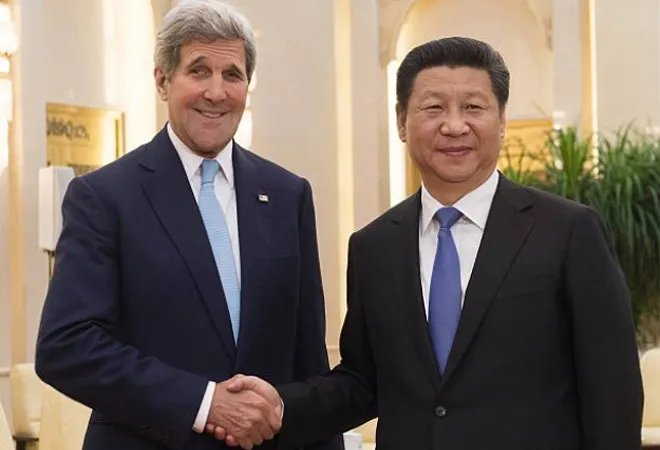
The visit by John Kerry, the United States (US) Special Envoy for Climate, to China ended on 20 July without any tangible progress. President Xi bluntly stated
that China’s climate goals “should and must be determined by ourselves, and never under the sway of others.” The discord between the two also casts a shadow on the prospects of reaching an agreement either at the G20 Summit in New Delhi or COP28 in Dubai later in the year.
President Xi bluntly stated that China’s climate goals “should and must be determined by ourselves, and never under the sway of others.”
The energy transition is a fight for the limited carbon space remaining.
China and developed countries have exhausted 80 percent of the global carbon budget; they continue to appropriate a disproportionate share of the remaining carbon space since their per capita consumption is much higher than India's. The US per capita consumption is
16.06 tons, followed by China at 7.1 tons, EU-28 at 6.41 tons, and India at 1.9 tons.
According to the International Energy Agency (IEA), the power sector accounts for 45 percent of India’s emissions. Moving towards the goal of net-zero emissions requires de-carbonising, which would require going beyond the power sector. As new sectors are brought under electrification based on clean energy sources, the quantum of electricity demand will increase steeply. What is the minimum quantum of electricity needed to reach net-zero emissions by 2070?
A study by Vivekananda International Foundation (VIF), with mathematical modelling done by IIT Bombay, has estimated a minimum demand of 24,000-30,000 TWhr for reaching net-zero emissions by 2070. An IEA report pegged the energy demand at
3,400 TWhr in 2040. According to NITI Aayog data,
India’s energy consumption in 2020 was 6,292 TWhr. Is it realistic to assume that India’s energy consumption two decades later would be half of the level in the pandemic year when economic activities had slowed down?
As new sectors are brought under electrification based on clean energy sources, the quantum of electricity demand will increase steeply.
The second finding of the VIF study is that the renewable high scenario will cost US$15.5 trillion, while a nuclear high scenario will need US$11.2 trillion by 2070. Renewable power plants appear cheaper in terms of the Levelised Cost of Electricity (LCOE). This methodology, however, does not capture systems costs including the cost of balancing power, which is borne by DISCOMS and is not reflected in the tariff. This was estimated by the Forum of Regulators at INR 2.12 per unit for renewables in 2021. Added to the renewable tariff of INR 2 per unit, this makes them more expensive than either coal (INR 3.25 per unit) or nuclear (INR 3.47 per unit).
An
OECD study has pointed out that 100 MW of nuclear power generates power equivalent to electricity produced by 600 MW of renewable due to the low Plant Load Factor of the latter. The higher capacity build-up required in the case of renewables makes them more expensive. An
MIT study based on case studies in the US and China stated that, ‘For achieving an emission target of 1 g-CO2/kw, the inclusion of nuclear power reduces the cost to almost half the level without nuclear power.’
India, though a sub-continent, is in a similar situation as the UK. It cannot draw from the regional grid, as most of its neighbours suffer from energy deficits.
Extreme weather events over extended areas make reliance on renewables risky. When North Sea winds dropped in September 2021, electricity costs went up five-fold in the United Kingdom (UK), while they doubled in the case of Germany. Why the difference? In both cases, wind power accounted for roughly 20 percent of electricity generation. However, Germany, given its continental location, can draw electricity from the regional grid. The UK does not have this advantage. India, though a sub-continent, is in a similar situation as the UK. It cannot draw from the regional grid, as most of its neighbours suffer from energy deficits. Bhutan exports electricity to India, but cannot meet the scale of Indian demand.
Germany has phased out nuclear power production, not its use.
It imports electricity from France and Czech Republic produced largely from nuclear power. It has the highest renewable penetration amongst major economies (
46.9 percent), but also the highest electricity tariff in the world.
Renewables also have very high transmission costs. The problem will become worse in the future as ultra-major renewable power plants will have to be located in remote locations such as the Rann of Kutch and Ladakh. This will entail longer transmission lines and higher costs. This will account for 80 percent of the delivered cost of electricity by 2100,
according to a McKinsey study.
It imports electricity from France and Czech Republic produced largely from nuclear power.
Renewables have the highest land footprint. A key finding of the VIF report is that the renewable high approach will require 412,033 square km. This is double the total surplus land of 2,00,000 square km available in India. A nuclear high scenario will require 183,565 square km.
There is growing pressure for early peaking of emissions.
The G7 Summit at Hiroshima, Japan, had called for major economies to accept ‘peaking’ of emissions by 2025. China has agreed to ‘peaking’ by 2030. India’s per capita emissions at 1,100 units are one-third of the global average. Early peaking before it has diversified to clean energy will impact its development trajectory.
While pushing for more ambitious climate targets, the developed countries have not shown ambition to increase financial assistance.
A McKinsey study estimated that the financing needed would be US$ 9.5 trillion annually at the global level, including US$3.5 trillion of additional financing. India, as G20 Chair, has estimated that US$4 trillion per annum will be required for the energy transition. The commitment of US$100 billion per annum for developing countries is paltry. Unfortunately, the Multilateral Development Banks (MDB) reforms will not bring much resources.
Larry Summer-N.K.Singh’s report has recommended tripling annual lending to US$400 billion. The dilution of the
World Bank’s equity-loan ratio from 20 percent to 19 percent would release only US$5 billion. Most of the resources have to be found internally. This requires restoring the health of the DISCOMs. Green finance based on private equity capital will come in only if the tariff is raised.
India, as G20 Chair, has estimated that US$4 trillion per annum will be required for the energy transition.
Renewables should be deployed as a distributed energy solution to minimise transmission costs. Ramping up nuclear power will require government support since resources on this scale cannot be raised internally by the Nuclear Power Corporation of India Limited (NPCIL). The UK and United Arab Emirates have allowed private, including foreign companies, to build and operate nuclear power plants against long-term tariff guarantees. This will require amending the Atomic Energy Act. Under the existing Act, PSUs may be encouraged to form joint ventures with NPCIL.
D. P. Srivastava is a Distinguished Fellow at the Vivekananda International Foundation and the Co-ordinator of the VIF Task Force on India’s Energy Transition in a Carbon-Constrained World
The views expressed above belong to the author(s). ORF research and analyses now available on Telegram! Click here to access our curated content — blogs, longforms and interviews.



 The visit by John Kerry, the United States (US) Special Envoy for Climate, to China ended on 20 July without any tangible progress. President Xi bluntly stated
The visit by John Kerry, the United States (US) Special Envoy for Climate, to China ended on 20 July without any tangible progress. President Xi bluntly stated  PREV
PREV


